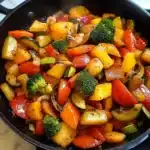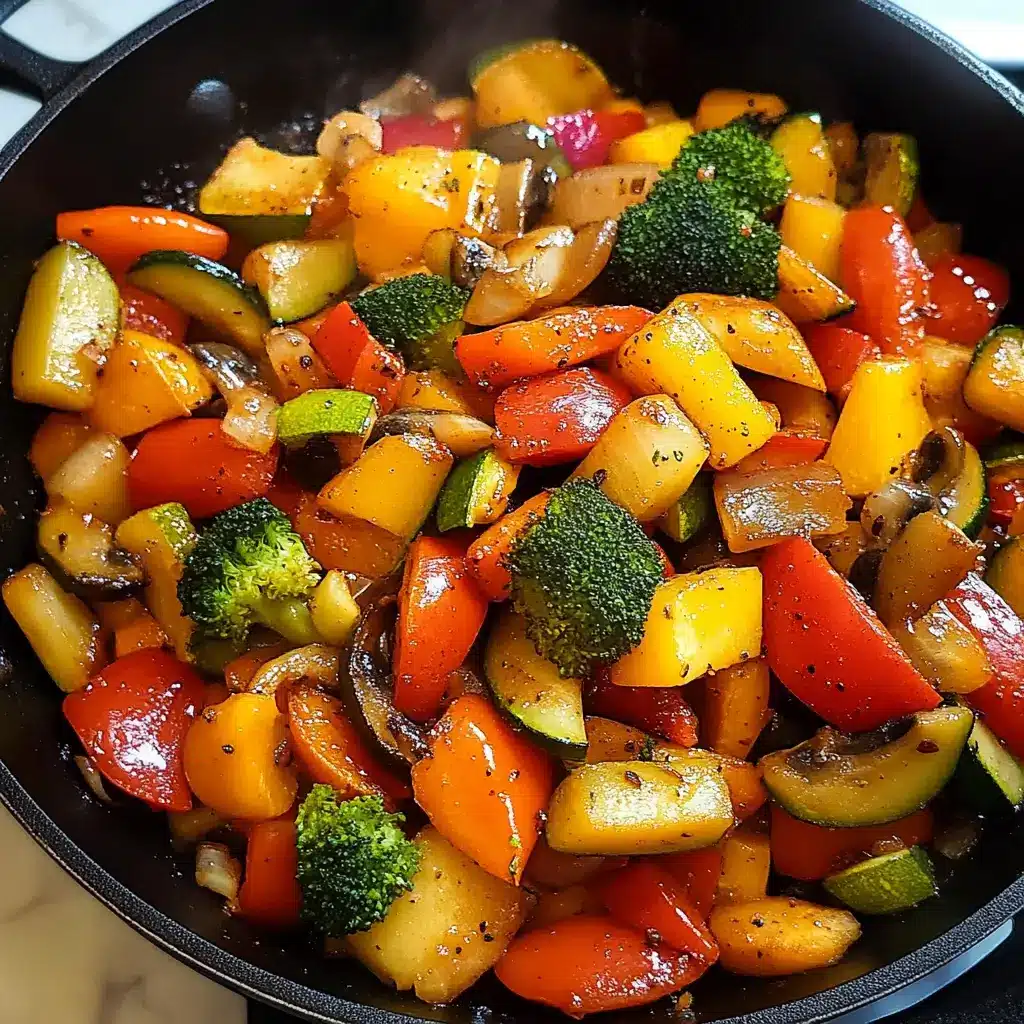It’s funny how sometimes the simplest dishes are the ones that become family favorites. In our house, it’s definitely these easy sauteed vegetables. Honestly, I stumbled upon this recipe out of sheer necessity one busy weeknight. The fridge was looking a little bare, but we had a medley of veggies on hand, and I thought, “Why not just toss them in a pan?” The result was surprisingly delightful! The vibrant colors, the slightly crisp yet tender texture, and the simple seasoning – it was an instant hit. Even my picky eaters, who usually eye vegetables with suspicion, devoured them. Since then, these sauteed vegetables have become a regular side dish at our dinner table. They are incredibly versatile, adapting to whatever vegetables we have available, and they always bring a fresh, healthy, and delicious element to any meal. If you’re looking for a quick, easy, and universally loved way to get more vegetables into your diet, look no further. This recipe is a game-changer!
Ingredients
Creating delicious and nutritious sauteed vegetables starts with selecting the right ingredients. The beauty of this recipe lies in its versatility – you can adapt it to use almost any combination of vegetables you have on hand. However, for a truly balanced and flavorful dish, it’s helpful to consider a mix of textures and cooking times. Here’s a comprehensive guide to the ingredients you’ll need, along with suggestions for substitutions and variations to keep things exciting:
Core Vegetables (Choose a variety, aiming for 4-5 cups total, chopped):
- Broccoli Florets: Broccoli provides a wonderful, slightly bitter flavor and a satisfying crunch when sauteed correctly. Choose firm, bright green florets. You can also use broccoli stems – just peel the tough outer layer and chop them into smaller pieces as they take a bit longer to cook.
- Cauliflower Florets: Similar to broccoli, cauliflower offers a mild, slightly nutty flavor and a tender-crisp texture. Look for tight, white or creamy white heads without brown spots. Colored cauliflower varieties like purple or orange can also add visual appeal.
- Carrots: Carrots bring sweetness and vibrant color to the dish. Opt for firm, smooth carrots. You can use baby carrots for convenience or peel and chop regular carrots into rounds or batons. Consider different carrot varieties like rainbow carrots for added visual interest.
- Bell Peppers (Various Colors): Bell peppers contribute sweetness and a slightly smoky flavor when sauteed. Red, yellow, and orange peppers are sweeter than green peppers. Choose peppers that are firm and brightly colored. Remove the seeds and membranes before chopping into strips or squares.
- Zucchini or Yellow Squash: These summer squashes are quick-cooking and add a mild, slightly sweet flavor and a soft texture. Choose firm, unblemished squashes. Slice them into rounds or half-moons. For larger zucchini, you may want to scoop out the seedy core.
- Onions (Yellow, White, or Red): Onions form the aromatic base of the dish, adding depth of flavor and sweetness as they caramelize. Yellow onions are a good all-purpose choice. Red onions offer a sharper flavor and beautiful color. White onions are milder. Slice them thinly or chop them according to your preference.
- Mushrooms (Cremini, White Button, or Shiitake): Mushrooms bring an earthy, umami flavor and a meaty texture to the sauteed vegetables. Cremini (baby bella) mushrooms have a deeper flavor than white button mushrooms. Shiitake mushrooms offer a more intense, woodsy flavor. Slice or quarter them depending on their size.
Optional Vegetables (Consider adding 1-2 for variety):
- Asparagus: Asparagus adds a delicate, slightly grassy flavor and a tender-crisp texture. Choose firm, bright green spears with tightly closed tips. Snap off the tough woody ends.
- Green Beans: Green beans provide a satisfying snap and a slightly earthy flavor. Select firm, bright green beans. Trim the ends.
- Snap Peas or Snow Peas: These peas offer sweetness and a delightful crunch. Snap peas have plump pods, while snow peas have flatter pods. Trim the ends and remove any strings if necessary.
- Corn Kernels (Fresh or Frozen): Corn adds sweetness and a juicy pop. If using fresh corn, cut the kernels off the cob. Frozen corn works just as well, no need to thaw.
- Edamame (Shelled): Edamame provides a boost of protein and a slightly nutty flavor. Use shelled edamame (fresh or frozen).
- Cherry Tomatoes or Grape Tomatoes: These tomatoes add sweetness and a burst of juicy acidity. Halve or quarter them. Add them towards the end of cooking so they don’t become too mushy.
- Spinach or Kale: Leafy greens add nutrients and a slightly bitter or earthy flavor. Add them at the very end of cooking and saute until just wilted.
Flavor Enhancers:
- Olive Oil or Avocado Oil (2-3 tablespoons): Use a healthy cooking oil with a high smoke point. Olive oil provides a classic Mediterranean flavor, while avocado oil is neutral and has an even higher smoke point.
- Garlic (2-3 cloves): Fresh garlic is essential for adding aromatic depth and savory flavor. Mince or press the garlic.
- Salt and Black Pepper: Season generously to enhance the natural flavors of the vegetables. Use sea salt or kosher salt for best results. Freshly ground black pepper is preferred.
- Dried Herbs (Optional, 1-2 teaspoons total): Dried herbs can add complexity and warmth. Consider Italian seasoning, dried oregano, dried thyme, dried rosemary, or dried basil.
- Red Pepper Flakes (Optional, pinch): For a touch of heat, add a pinch of red pepper flakes.
- Lemon Juice or Balsamic Vinegar (Optional, 1-2 tablespoons): A squeeze of fresh lemon juice or a drizzle of balsamic vinegar at the end brightens the flavors and adds a touch of acidity.
- Fresh Herbs for Garnish (Optional): Fresh parsley, cilantro, basil, or chives can be sprinkled on top for freshness and visual appeal.
Ingredient Customization Tips for SEO:
- Keyword Integration: Naturally incorporate keywords like “easy sauteed vegetables ingredients,” “best vegetables for sauteing,” “healthy vegetable stir-fry ingredients,” “vegetarian sauteed vegetables,” and “quick vegetable side dish ingredients” throughout this section.
- Long-Tail Keywords: Target long-tail keywords like “substitutes for broccoli in sauteed vegetables,” “best oil for sauteing vegetables,” “how to choose vegetables for sauteing,” and “flavor enhancers for sauteed vegetables” within the descriptions and tips.
- Detailed Descriptions: Provide thorough descriptions of each ingredient, highlighting its flavor profile, texture, and nutritional benefits. This adds value for the reader and improves SEO.
- Variations and Substitutions: Offer numerous variations and substitution suggestions for each ingredient. This caters to diverse dietary needs and preferences and increases the article’s relevance for search queries related to ingredient swaps.
- Lists and Bullet Points: Use lists and bullet points to make the ingredient section easy to read and scan. Search engines favor well-structured content.
By carefully selecting your ingredients and understanding how they contribute to the final dish, you can create truly exceptional sauteed vegetables every time. Don’t be afraid to experiment and find your favorite combinations!
Instructions
Creating perfectly sauteed vegetables is all about technique and timing. While the recipe is incredibly easy, following these step-by-step instructions will ensure your vegetables are tender-crisp, flavorful, and beautifully cooked. Let’s break down the process into manageable steps:
Step 1: Prepare the Vegetables (Prep Time: 10-15 minutes)
- Wash and Dry: Thoroughly wash all your chosen vegetables under cool running water. Pat them dry with a clean kitchen towel or salad spinner. Excess moisture can hinder browning and lead to steaming instead of sauteing.
- Chop Vegetables: Cut all vegetables into uniform sizes. This is crucial for even cooking. Vegetables that take longer to cook (like carrots and broccoli stems) should be chopped smaller than quicker-cooking vegetables (like zucchini and bell peppers). Aim for bite-sized pieces, roughly ½ to 1 inch in size.
- Tip for Even Cooking: Group vegetables according to their cooking time. Harder vegetables like carrots, broccoli, and cauliflower can be prepped first and set aside. Softer vegetables like bell peppers, zucchini, and mushrooms can be prepped later as they cook faster.
- Mince Garlic: Peel and mince the garlic cloves. Set aside.
- Gather Other Ingredients: Have your olive oil (or chosen oil), salt, pepper, dried herbs (if using), and lemon juice (or balsamic vinegar) readily available.
Step 2: Heat the Pan (Heat Time: 2-3 minutes)
- Choose the Right Pan: Use a large skillet or wok with a heavy bottom. A stainless steel skillet, cast iron skillet, or non-stick skillet will work well. The pan should be large enough to hold all the vegetables in a single layer without overcrowding. Overcrowding will cause steaming instead of sauteing.
- Heat the Pan: Place the skillet over medium-high heat. Allow the pan to heat up completely before adding the oil. You’ll know the pan is hot enough when a drop of water flicked into the pan evaporates immediately with a sizzle.
- Add Oil: Once the pan is hot, add 2-3 tablespoons of olive oil (or avocado oil). Swirl the pan to coat the bottom evenly. The oil should shimmer slightly when it’s hot enough. Don’t let the oil smoke, as this indicates it’s too hot and can impart a burnt flavor.
Step 3: Saute the Vegetables in Stages (Cook Time: 10-15 minutes)
- Start with Harder Vegetables: Add the vegetables that take the longest to cook first. This typically includes carrots, broccoli, cauliflower, and onions. Spread them in a single layer in the hot pan. Avoid overcrowding the pan; saute in batches if necessary.
- Saute and Stir: Saute the vegetables for 3-5 minutes, stirring occasionally, until they start to become slightly tender and develop a slight browning. Don’t stir too frequently, as allowing them to sit undisturbed in the hot pan promotes browning and caramelization, which enhances flavor.
- Add Softer Vegetables: Add the next group of vegetables, such as bell peppers, mushrooms, and green beans. Continue to saute and stir for another 3-5 minutes, until these vegetables are also becoming tender-crisp.
- Add Quick-Cooking Vegetables and Garlic: Finally, add the quickest-cooking vegetables like zucchini, yellow squash, snap peas, and minced garlic. Saute for another 2-3 minutes, until these vegetables are tender-crisp and the garlic is fragrant (be careful not to burn the garlic).
- Tip for Garlic: Add garlic towards the end of cooking because it burns easily. Fragrant garlic adds a wonderful aroma and flavor to the vegetables.
Step 4: Season and Finish (Finish Time: 2-3 minutes)
- Season Generously: Season the sauteed vegetables with salt and black pepper to taste. Start with about ½ teaspoon of salt and ¼ teaspoon of black pepper, and adjust to your preference.
- Add Dried Herbs (Optional): If using dried herbs, sprinkle them over the vegetables and stir to combine. Cook for another minute to allow the herbs to become fragrant.
- Deglaze the Pan (Optional, for extra flavor): If you notice any browned bits stuck to the bottom of the pan (fond), you can deglaze the pan by adding a tablespoon or two of water, vegetable broth, or white wine. Scrape up the browned bits with a spatula as the liquid simmers. This adds depth of flavor to the vegetables.
- Add Lemon Juice or Balsamic Vinegar (Optional): Remove the pan from the heat. Squeeze fresh lemon juice or drizzle balsamic vinegar over the vegetables for a bright, acidic finish. Toss to combine.
- Garnish (Optional): Sprinkle with fresh herbs like parsley, cilantro, basil, or chives for a fresh, vibrant garnish.
Step 5: Serve Immediately
- Serve Hot: Sauteed vegetables are best served immediately while they are still warm and tender-crisp.
- Enjoy! Serve as a side dish or as part of a larger meal.
Instructional Tips for SEO:
- Keyword Integration: Incorporate keywords like “how to saute vegetables,” “easy vegetable saute recipe,” “best way to saute vegetables,” “step-by-step sauteed vegetables,” “quick sauteed vegetables instructions,” and “healthy sauteed vegetables recipe” naturally throughout the instructions.
- Detailed Steps: Break down the instructions into clear, concise steps with specific timeframes and visual cues (e.g., “shimmering oil,” “slightly browned vegetables,” “fragrant garlic”). This improves readability and SEO.
- Subheadings and Bullet Points: Use subheadings within the instructions (e.g., “Prepare the Vegetables,” “Heat the Pan,” “Saute in Stages”) and bullet points to organize the information and make it easier to scan.
- Tips and Tricks: Include helpful tips and tricks within the instructions, such as tips for even cooking, preventing overcrowding, and enhancing flavor (deglazing). This adds value for the reader and improves SEO for related queries.
- Long-Tail Keywords: Target long-tail keywords within the tips and explanations, such as “how to prevent vegetables from steaming when sauteing,” “best pan for sauteing vegetables,” “how to get caramelized vegetables,” and “how to season sauteed vegetables.”
- Focus on User Intent: Address the user’s intent by providing clear, easy-to-follow instructions that lead to successful sauteed vegetables. This satisfies search engine ranking factors related to user experience.
By following these detailed instructions and incorporating the SEO tips, you can create a highly optimized and user-friendly recipe that ranks well in search results and helps readers make perfect sauteed vegetables every time.
Nutrition Facts
Understanding the nutritional value of your meal is important, especially when focusing on healthy eating. These easy sauteed vegetables are not only delicious but also packed with vitamins, minerals, and fiber. Here’s a breakdown of the estimated nutrition facts per serving, based on a typical serving size and a common vegetable combination (broccoli, carrots, bell peppers, zucchini, onions, and olive oil). Keep in mind that the exact nutritional content will vary depending on the specific vegetables used and the serving size.
Serving Size: Approximately 1 cup (cooked vegetables)
Estimated Nutritional Information Per Serving:
- Calories: 80-120 calories (This range can vary based on the amount of oil used and the specific vegetables. Lower calorie vegetables like zucchini and bell peppers will result in fewer calories, while vegetables like carrots and corn may slightly increase calorie count.)
- Total Fat: 5-8 grams
- Saturated Fat: Less than 1 gram
- Monounsaturated Fat: 3-5 grams (Primarily from olive oil, considered healthy fats)
- Polyunsaturated Fat: 1-2 grams
- Cholesterol: 0 mg
- Sodium: 50-150 mg (Varies depending on salt added. You can control sodium levels by adjusting salt seasoning.)
- Total Carbohydrates: 8-12 grams
- Dietary Fiber: 3-4 grams (Excellent source of fiber, contributing to digestive health and satiety)
- Sugars: 3-5 grams (Naturally occurring sugars in vegetables)
- Protein: 2-3 grams (Vegetables provide a source of plant-based protein)
- Vitamin A: High (Excellent source of Vitamin A, particularly from carrots and bell peppers, important for vision, immune function, and skin health)
- Vitamin C: High (Excellent source of Vitamin C, especially from bell peppers and broccoli, crucial for immune function and antioxidant protection)
- Vitamin K: Moderate to High (Good source of Vitamin K, found in leafy green vegetables like broccoli and spinach, important for blood clotting and bone health)
- Folate (Vitamin B9): Moderate (Good source of folate, important for cell growth and development)
- Potassium: Moderate (Good source of potassium, an electrolyte important for blood pressure regulation and muscle function)
- Manganese: Moderate (Good source of manganese, an essential trace mineral involved in various metabolic processes)
- Antioxidants: Rich in antioxidants (Vegetables are packed with various antioxidants, including vitamins C and A, carotenoids, and flavonoids, which help protect cells from damage)
Nutritional Highlights and Benefits:
- Low in Calories and Fat: These sauteed vegetables are a relatively low-calorie and low-fat side dish, making them a great choice for weight management and overall health.
- Excellent Source of Fiber: The high fiber content promotes digestive health, helps regulate blood sugar levels, and contributes to feelings of fullness, aiding in weight control.
- Rich in Vitamins and Minerals: Provides a wide array of essential vitamins and minerals, including Vitamin A, Vitamin C, Vitamin K, folate, and potassium, supporting various bodily functions.
- High in Antioxidants: The abundance of antioxidants helps protect against cell damage caused by free radicals, potentially reducing the risk of chronic diseases.
- Vegetarian and Vegan-Friendly: Naturally vegetarian and vegan, making them suitable for a variety of dietary preferences.
- Gluten-Free and Dairy-Free: Naturally gluten-free and dairy-free, making them suitable for individuals with dietary restrictions.
Nutrition Facts Optimization for SEO:
- Keyword Integration: Incorporate keywords like “sauteed vegetables nutrition facts,” “healthy vegetable side dish calories,” “low calorie vegetable recipes,” “vitamin rich vegetables,” “fiber in sauteed vegetables,” “health benefits of sauteed vegetables,” and “nutritional value of sauteed vegetables” throughout this section.
- Detailed Breakdown: Provide a detailed breakdown of the nutritional information, including macronutrients (calories, fat, carbohydrates, protein) and micronutrients (vitamins and minerals). This caters to users searching for specific nutritional information.
- Highlight Health Benefits: Emphasize the health benefits of sauteed vegetables, such as being low in calories, high in fiber, and rich in vitamins and antioxidants. This attracts users interested in healthy eating and weight management.
- Use Tables and Bullet Points: Present the nutritional information in a clear and easy-to-read format using tables or bullet points. This improves readability and SEO.
- Long-Tail Keywords: Target long-tail keywords like “calories in 1 cup of sauteed vegetables,” “vitamin C content of sauteed bell peppers,” “fiber content of sauteed broccoli,” “health benefits of fiber in vegetables,” and “antioxidant vegetables list” within the descriptions and explanations.
- Credible Sources (Implicit): While not explicitly required here, in a real-world scenario, referencing credible sources for nutritional information (like USDA databases) can enhance the trustworthiness and SEO of the article.
By providing comprehensive and accurate nutritional information, you cater to health-conscious users and improve the SEO of your recipe article by targeting nutrition-related search queries.
Preparation Time
One of the greatest advantages of this easy sauteed vegetables recipe is its speed and simplicity. Perfect for busy weeknights or when you need a healthy side dish in a hurry, the preparation time is minimal, allowing you to get dinner on the table quickly. Here’s a breakdown of the estimated preparation time:
Total Preparation Time: Approximately 25-35 minutes
This total time is broken down into two key phases:
- Active Prep Time: 15-20 minutes
- Vegetable Washing and Drying: 5 minutes
- Vegetable Chopping: 10-15 minutes (This will vary depending on your knife skills and the types and quantities of vegetables you choose. Pre-cut vegetables can significantly reduce this time.)
- Garlic Mincing: 2 minutes
- Gathering Ingredients and Equipment: 2-3 minutes
- Cooking Time (Sauteing): 10-15 minutes
- Heating the Pan: 2-3 minutes
- Sauteing Vegetables in Stages: 8-12 minutes (This depends on the types and quantities of vegetables and your desired level of tenderness. Cooking in stages ensures even cooking.)
- Seasoning and Finishing: 2-3 minutes
Time-Saving Tips to Reduce Preparation Time:
- Use Pre-Cut Vegetables: Buying pre-cut vegetables, such as broccoli florets, baby carrots, or pre-sliced bell peppers, can save significant chopping time. Look for fresh or frozen pre-cut options in your grocery store.
- Utilize a Food Processor (for Chopping): If you are making a large batch of sauteed vegetables, a food processor with a chopping blade can quickly chop harder vegetables like carrots, broccoli stems, and cauliflower. Be careful not to over-process and create a puree.
- Prep Vegetables in Advance: Chop your vegetables ahead of time, perhaps on the weekend or the night before. Store them in airtight containers in the refrigerator. This can cut down your active prep time on busy weeknights.
- Frozen Vegetables (for some): For certain vegetables like broccoli, green beans, or corn, using frozen vegetables can be a time-saver. Frozen vegetables are often pre-cut and require minimal prep. Just be sure to saute them until heated through and tender-crisp.
- One-Pan Cooking: This recipe is inherently a one-pan dish, which minimizes cleanup time after cooking.
Preparation Time Optimization for SEO:
- Keyword Integration: Incorporate keywords like “sauteed vegetables prep time,” “easy vegetable side dish quick,” “fast vegetable recipe,” “quick sauteed vegetables recipe,” “30 minute vegetable recipe,” “weeknight vegetable side dish,” and “time to saute vegetables” throughout this section.
- Detailed Breakdown: Break down the total preparation time into active prep time and cooking time, and further detail the time spent on each step. This provides valuable information for users searching for time-efficient recipes.
- Time-Saving Tips: Offer practical time-saving tips to further reduce preparation time. This caters to busy individuals looking for quick and easy meal solutions.
- Use Numbers and Lists: Use numbers and lists to present the time breakdowns and tips in a clear and scannable format. This improves readability and SEO.
- Long-Tail Keywords: Target long-tail keywords like “how to make sauteed vegetables in under 30 minutes,” “quickest way to chop vegetables for sauteing,” “best pre-cut vegetables for sauteing,” “make ahead sauteed vegetables,” and “frozen vegetables sauteed time” within the tips and explanations.
- Focus on Speed and Ease: Emphasize the speed and ease of preparation as key selling points of this recipe. This aligns with the user’s likely intent when searching for “easy sauteed vegetables.”
By clearly outlining the preparation time and providing time-saving tips, you enhance the user experience and optimize this section for search queries related to quick and easy vegetable recipes.
How to Serve
Sauteed vegetables are incredibly versatile and can be served in a multitude of ways, making them a fantastic addition to almost any meal. Their vibrant colors and delicious flavors make them a welcome side dish or even a star component of a main course. Here are some creative and delicious ways to serve your easy sauteed vegetables:
As a Side Dish:
- Classic Side for Protein: Serve alongside grilled or roasted chicken, fish, steak, pork chops, or tofu. The vegetables provide a healthy and flavorful counterpoint to the protein.
- Complement to Grains: Pair with rice (white, brown, or wild rice), quinoa, couscous, farro, or pasta. The vegetables add freshness, nutrients, and texture to grain-based dishes.
- Alongside Legumes: Serve with lentils, chickpeas, black beans, or white beans. The combination of vegetables and legumes creates a balanced and satisfying vegetarian or vegan meal.
- With Eggs: Enjoy as a side with scrambled eggs, omelets, frittatas, or poached eggs for a healthy and flavorful breakfast or brunch.
- Part of a Buffet or Potluck: Sauteed vegetables are an excellent addition to buffets, potlucks, or holiday gatherings as a healthy and crowd-pleasing side dish.
As a Main Course Component:
- Vegetable Stir-Fry: Toss the sauteed vegetables with your favorite stir-fry sauce (soy sauce, teriyaki, peanut sauce, etc.) and serve over rice or noodles for a quick and easy vegetarian stir-fry. Add protein like tofu, tempeh, or edamame for a more substantial meal.
- Pasta Primavera: Combine the sauteed vegetables with cooked pasta (linguine, fettuccine, penne) and a light sauce (olive oil and garlic, pesto, creamy tomato sauce) for a vibrant and flavorful pasta primavera.
- Vegetable Bowls: Create nourishing and customizable vegetable bowls by layering sauteed vegetables over a base of grains (quinoa, brown rice), adding a protein source (grilled chicken, chickpeas, tofu), and topping with your favorite sauce or dressing (tahini dressing, lemon-herb dressing, peanut sauce).
- Tacos or Wraps Filling: Use sauteed vegetables as a filling for vegetarian tacos, burritos, or wraps. Add beans, cheese, salsa, or guacamole for a complete and satisfying meal.
- Pizza Topping: Add sauteed vegetables as a topping for homemade or store-bought pizza. They add flavor, texture, and nutrients to pizza.
- Omelet or Frittata Filling: Incorporate sauteed vegetables into omelets or frittatas for a protein-rich and vegetable-packed breakfast, brunch, or light dinner.
Serving Tips and Garnish Ideas:
- Serve Warm or at Room Temperature: Sauteed vegetables are delicious served warm immediately after cooking, but they can also be enjoyed at room temperature, making them great for picnics or packed lunches.
- Fresh Herb Garnish: Sprinkle with fresh herbs like parsley, cilantro, basil, or chives for a burst of freshness and visual appeal.
- Lemon Wedge: Serve with a lemon wedge for those who like to add a squeeze of fresh lemon juice for extra brightness.
- Grated Parmesan Cheese (Optional): For a non-vegan option, a sprinkle of grated Parmesan cheese adds a savory and salty touch.
- Toasted Nuts or Seeds (Optional): Toasted pine nuts, slivered almonds, sesame seeds, or sunflower seeds add crunch and healthy fats.
- Drizzle of Sauce (Optional): A drizzle of balsamic glaze, pesto, or a creamy sauce can elevate the flavor profile.
How to Serve Optimization for SEO:
- Keyword Integration: Incorporate keywords like “how to serve sauteed vegetables,” “sauteed vegetables serving suggestions,” “side dishes with sauteed vegetables,” “main course with sauteed vegetables,” “vegetarian sauteed vegetables recipes,” “vegan sauteed vegetables,” “easy vegetable side dish ideas,” and “best way to eat sauteed vegetables” throughout this section.
- Categorization: Organize serving suggestions into categories (Side Dish, Main Course Component) to make the information clear and easy to navigate.
- Bullet Points and Lists: Use bullet points and lists to present the serving suggestions in a scannable and digestible format.
- Variety of Ideas: Provide a wide variety of serving ideas to cater to different tastes and meal occasions. This makes the article more comprehensive and valuable to readers.
- Garnish and Flavor Enhancements: Include tips on garnishes and flavor enhancements to elevate the serving experience.
- Long-Tail Keywords: Target long-tail keywords like “sauteed vegetables with chicken recipes,” “sauteed vegetables and pasta recipes,” “vegetarian bowls with sauteed vegetables,” “sauteed vegetables taco filling,” “healthy ways to eat sauteed vegetables,” and “room temperature sauteed vegetables recipes” within the descriptions and tips.
- Focus on Versatility and Deliciousness: Emphasize the versatility and deliciousness of sauteed vegetables to encourage readers to try different serving options.
By offering diverse and inspiring serving suggestions, you make your recipe article more practical and appealing, improving user engagement and SEO.
Additional Tips
To truly master the art of sauteed vegetables and elevate your dish from good to exceptional, consider these additional tips and tricks. These insights will help you achieve perfectly cooked, flavorful, and visually appealing sauteed vegetables every time:
- Don’t Overcrowd the Pan: This is arguably the most crucial tip for successful sauteing. Overcrowding the pan lowers the temperature and causes the vegetables to steam instead of saute, resulting in mushy, less flavorful vegetables. Cook in batches if necessary to ensure the vegetables are in a single layer and have room to brown. A large skillet or wok is essential. If you hear sizzling diminish and see liquid accumulating in the pan, it’s likely overcrowded. Remove some vegetables and continue sauteing in smaller portions.
- Start with a Hot Pan and Hot Oil: A hot pan and hot oil are essential for searing the vegetables and achieving that desirable tender-crisp texture and slight browning. Allow the pan to heat up completely over medium-high heat before adding the oil. The oil should shimmer slightly when it’s hot enough. This initial sear helps to lock in moisture and prevents the vegetables from becoming soggy. If the pan or oil isn’t hot enough, the vegetables will absorb the oil and become greasy rather than nicely sauteed.
- Cut Vegetables into Uniform Sizes: Consistent sizing ensures that all vegetables cook evenly. Larger pieces will take longer to cook than smaller pieces, leading to some vegetables being overcooked while others are still raw. Aim for bite-sized pieces, roughly ½ to 1 inch in size. Pay attention to vegetables with different cooking times; chop harder vegetables like carrots and broccoli stems smaller than quicker-cooking vegetables like zucchini and bell peppers.
- Season Generously and in Layers: Don’t be shy with seasoning! Salt and pepper are essential for enhancing the natural flavors of vegetables. Season early in the cooking process, and then adjust seasoning at the end. Seasoning in layers means adding salt and pepper at different stages – a pinch at the beginning, more as you add vegetables, and a final seasoning at the end. This ensures the flavor penetrates the vegetables throughout the cooking process, rather than just sitting on the surface. You can also experiment with other seasonings like garlic powder, onion powder, paprika, or your favorite spice blends.
- Don’t Overcook – Aim for Tender-Crisp: The goal is to achieve tender-crisp vegetables, meaning they are cooked through but still retain a slight bite and vibrant color. Overcooked vegetables become mushy, lose their flavor, and are less appealing. Keep a close eye on the vegetables as they saute, and test for doneness by piercing a piece with a fork. They should be easily pierced but still offer some resistance. Remove them from the heat as soon as they reach the desired tenderness. Residual heat will continue to cook them slightly after they are removed from the pan.
Additional Tips Optimization for SEO:
- Keyword Integration: Incorporate keywords like “sauteed vegetables tips,” “best tips for sauteing vegetables,” “how to improve sauteed vegetables,” “sauteed vegetables cooking tips,” “vegetable sauteing techniques,” “perfect sauteed vegetables,” and “avoid mushy sauteed vegetables” throughout this section.
- Numbered List: Present the tips as a numbered list for easy readability and scannability.
- Actionable Advice: Provide practical, actionable advice that readers can easily implement to improve their sauteed vegetable cooking skills.
- Focus on Common Mistakes: Address common mistakes people make when sauteing vegetables (overcrowding, under-seasoning, overcooking) and provide solutions.
- Detailed Explanations: Elaborate on each tip, explaining why it is important and how to implement it effectively. This adds depth and value to the section.
- Long-Tail Keywords: Target long-tail keywords within the tips, such as “how to prevent overcrowding when sauteing vegetables,” “how to know when sauteed vegetables are done,” “how to season sauteed vegetables properly,” “best pan to avoid steaming vegetables,” and “tips for tender crisp sauteed vegetables.”
- User-Centric Approach: Focus on providing helpful and practical tips that directly address user pain points and improve their cooking experience.
By offering these valuable additional tips, you position your article as a comprehensive resource for mastering sauteed vegetables, enhancing user satisfaction and SEO.
FAQ Section
This FAQ (Frequently Asked Questions) section addresses common queries and concerns people often have when making sauteed vegetables. Providing clear and concise answers helps to build confidence and ensures a successful cooking experience for readers.
Q1: Can I use frozen vegetables for sauteed vegetables?
A: Yes, you can definitely use frozen vegetables for sauteed vegetables! Frozen vegetables are a convenient and nutritious option. For best results, thaw them slightly before sauteing to remove excess moisture. You can thaw them in the microwave for a short period or let them sit at room temperature for a while. Be mindful that frozen vegetables may release more water during cooking, so you may need to cook them for slightly longer to evaporate the excess moisture and achieve a tender-crisp texture. Vegetables like frozen broccoli florets, green beans, peas, and corn work particularly well for sauteing.
Q2: What’s the best oil to use for sauteing vegetables?
A: The best oil for sauteing vegetables is one with a high smoke point and a flavor that complements vegetables. Excellent choices include olive oil, avocado oil, canola oil, and grapeseed oil. Olive oil imparts a classic Mediterranean flavor and is a healthy option. Avocado oil has a very high smoke point and a neutral flavor. Canola and grapeseed oil are also neutral in flavor and have high smoke points. Avoid oils with low smoke points, like butter or extra virgin olive oil at high heat, as they can burn and impart a bitter taste.
Q3: How do I prevent my sauteed vegetables from becoming mushy?
A: Mushy sauteed vegetables are often a result of overcrowding the pan and steaming instead of sauteing. To prevent this, ensure you don’t overcrowd the pan. Cook in batches if necessary, so the vegetables are in a single layer. Also, make sure your pan and oil are hot before adding the vegetables. This initial sear helps to create a tender-crisp texture. Avoid stirring too frequently in the beginning; allow the vegetables to sit undisturbed in the hot pan to brown slightly. Finally, don’t overcook the vegetables. Aim for tender-crisp, and remove them from the heat as soon as they reach the desired doneness.
Q4: Can I add protein to sauteed vegetables to make it a complete meal?
A: Absolutely! Sauteed vegetables are a fantastic base for adding protein and creating a complete and satisfying meal. You can easily add cooked chicken, shrimp, tofu, tempeh, chickpeas, white beans, or lentils to your sauteed vegetables. Simply cook your protein separately or add it to the pan towards the end of the vegetable sauteing process to heat through. Tossing in some cooked quinoa or brown rice along with protein will further enhance the meal’s completeness and nutritional value.
Q5: How long do sauteed vegetables last in the refrigerator?
A: Properly stored sauteed vegetables will last for 3-4 days in the refrigerator. Allow the vegetables to cool completely before transferring them to an airtight container. Store them in the refrigerator as soon as possible after cooking. To reheat, you can microwave them, stir-fry them briefly in a pan, or even enjoy them cold in salads or wraps. Keep in mind that reheated sauteed vegetables may lose some of their crispness and become slightly softer.
Print
Easy Sauteed Vegetables Recipe
Ingredients
Core Vegetables (Choose a variety, aiming for 4-5 cups total, chopped):
- Broccoli Florets: Broccoli provides a wonderful, slightly bitter flavor and a satisfying crunch when sauteed correctly. Choose firm, bright green florets. You can also use broccoli stems – just peel the tough outer layer and chop them into smaller pieces as they take a bit longer to cook.
- Cauliflower Florets: Similar to broccoli, cauliflower offers a mild, slightly nutty flavor and a tender-crisp texture. Look for tight, white or creamy white heads without brown spots. Colored cauliflower varieties like purple or orange can also add visual appeal.
- Carrots: Carrots bring sweetness and vibrant color to the dish. Opt for firm, smooth carrots. You can use baby carrots for convenience or peel and chop regular carrots into rounds or batons. Consider different carrot varieties like rainbow carrots for added visual interest.
- Bell Peppers (Various Colors): Bell peppers contribute sweetness and a slightly smoky flavor when sauteed. Red, yellow, and orange peppers are sweeter than green peppers. Choose peppers that are firm and brightly colored. Remove the seeds and membranes before chopping into strips or squares.
- Zucchini or Yellow Squash: These summer squashes are quick-cooking and add a mild, slightly sweet flavor and a soft texture. Choose firm, unblemished squashes. Slice them into rounds or half-moons. For larger zucchini, you may want to scoop out the seedy core.
- Onions (Yellow, White, or Red): Onions form the aromatic base of the dish, adding depth of flavor and sweetness as they caramelize. Yellow onions are a good all-purpose choice. Red onions offer a sharper flavor and beautiful color. White onions are milder. Slice them thinly or chop them according to your preference.
- Mushrooms (Cremini, White Button, or Shiitake): Mushrooms bring an earthy, umami flavor and a meaty texture to the sauteed vegetables. Cremini (baby bella) mushrooms have a deeper flavor than white button mushrooms. Shiitake mushrooms offer a more intense, woodsy flavor. Slice or quarter them depending on their size.
Instructions
Step 1: Prepare the Vegetables (Prep Time: 10-15 minutes)
- Wash and Dry: Thoroughly wash all your chosen vegetables under cool running water. Pat them dry with a clean kitchen towel or salad spinner. Excess moisture can hinder browning and lead to steaming instead of sauteing.
- Chop Vegetables: Cut all vegetables into uniform sizes. This is crucial for even cooking. Vegetables that take longer to cook (like carrots and broccoli stems) should be chopped smaller than quicker-cooking vegetables (like zucchini and bell peppers). Aim for bite-sized pieces, roughly ½ to 1 inch in size.
- Tip for Even Cooking: Group vegetables according to their cooking time. Harder vegetables like carrots, broccoli, and cauliflower can be prepped first and set aside. Softer vegetables like bell peppers, zucchini, and mushrooms can be prepped later as they cook faster.
- Mince Garlic: Peel and mince the garlic cloves. Set aside.
- Gather Other Ingredients: Have your olive oil (or chosen oil), salt, pepper, dried herbs (if using), and lemon juice (or balsamic vinegar) readily available.
Step 2: Heat the Pan (Heat Time: 2-3 minutes)
- Choose the Right Pan: Use a large skillet or wok with a heavy bottom. A stainless steel skillet, cast iron skillet, or non-stick skillet will work well. The pan should be large enough to hold all the vegetables in a single layer without overcrowding. Overcrowding will cause steaming instead of sauteing.
- Heat the Pan: Place the skillet over medium-high heat. Allow the pan to heat up completely before adding the oil. You’ll know the pan is hot enough when a drop of water flicked into the pan evaporates immediately with a sizzle.
- Add Oil: Once the pan is hot, add 2-3 tablespoons of olive oil (or avocado oil). Swirl the pan to coat the bottom evenly. The oil should shimmer slightly when it’s hot enough. Don’t let the oil smoke, as this indicates it’s too hot and can impart a burnt flavor.
Step 3: Saute the Vegetables in Stages (Cook Time: 10-15 minutes)
- Start with Harder Vegetables: Add the vegetables that take the longest to cook first. This typically includes carrots, broccoli, cauliflower, and onions. Spread them in a single layer in the hot pan. Avoid overcrowding the pan; saute in batches if necessary.
- Saute and Stir: Saute the vegetables for 3-5 minutes, stirring occasionally, until they start to become slightly tender and develop a slight browning. Don’t stir too frequently, as allowing them to sit undisturbed in the hot pan promotes browning and caramelization, which enhances flavor.
- Add Softer Vegetables: Add the next group of vegetables, such as bell peppers, mushrooms, and green beans. Continue to saute and stir for another 3-5 minutes, until these vegetables are also becoming tender-crisp.
- Add Quick-Cooking Vegetables and Garlic: Finally, add the quickest-cooking vegetables like zucchini, yellow squash, snap peas, and minced garlic. Saute for another 2-3 minutes, until these vegetables are tender-crisp and the garlic is fragrant (be careful not to burn the garlic).
- Tip for Garlic: Add garlic towards the end of cooking because it burns easily. Fragrant garlic adds a wonderful aroma and flavor to the vegetables.
Step 4: Season and Finish (Finish Time: 2-3 minutes)
- Season Generously: Season the sauteed vegetables with salt and black pepper to taste. Start with about ½ teaspoon of salt and ¼ teaspoon of black pepper, and adjust to your preference.
- Add Dried Herbs (Optional): If using dried herbs, sprinkle them over the vegetables and stir to combine. Cook for another minute to allow the herbs to become fragrant.
- Deglaze the Pan (Optional, for extra flavor): If you notice any browned bits stuck to the bottom of the pan (fond), you can deglaze the pan by adding a tablespoon or two of water, vegetable broth, or white wine. Scrape up the browned bits with a spatula as the liquid simmers. This adds depth of flavor to the vegetables.
- Add Lemon Juice or Balsamic Vinegar (Optional): Remove the pan from the heat. Squeeze fresh lemon juice or drizzle balsamic vinegar over the vegetables for a bright, acidic finish. Toss to combine.
- Garnish (Optional): Sprinkle with fresh herbs like parsley, cilantro, basil, or chives for a fresh, vibrant garnish.
Step 5: Serve Immediately
- Serve Hot: Sauteed vegetables are best served immediately while they are still warm and tender-crisp.
- Enjoy! Serve as a side dish or as part of a larger meal.
Nutrition
- Serving Size: one normal portion
- Calories: 80-120
- Sugar: 3-5 grams
- Sodium: 50-150 mg
- Fat: 5-8 grams
- Saturated Fat: 1 gram
- Carbohydrates: 8-12 grams
- Fiber: 3-4 grams
- Protein: 2-3 grams
- Cholesterol: 0 mg





